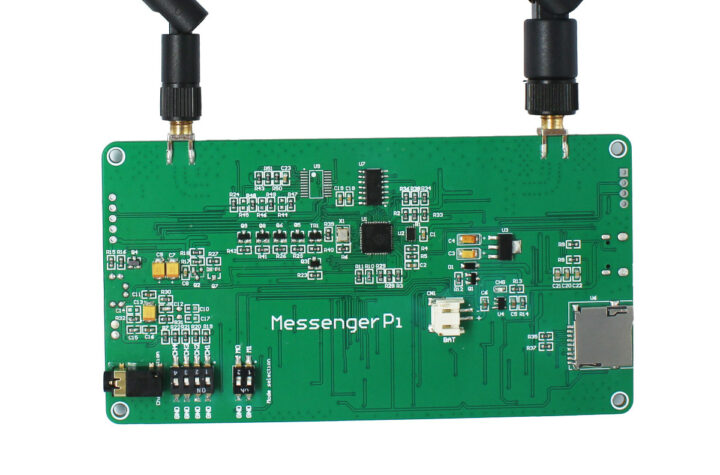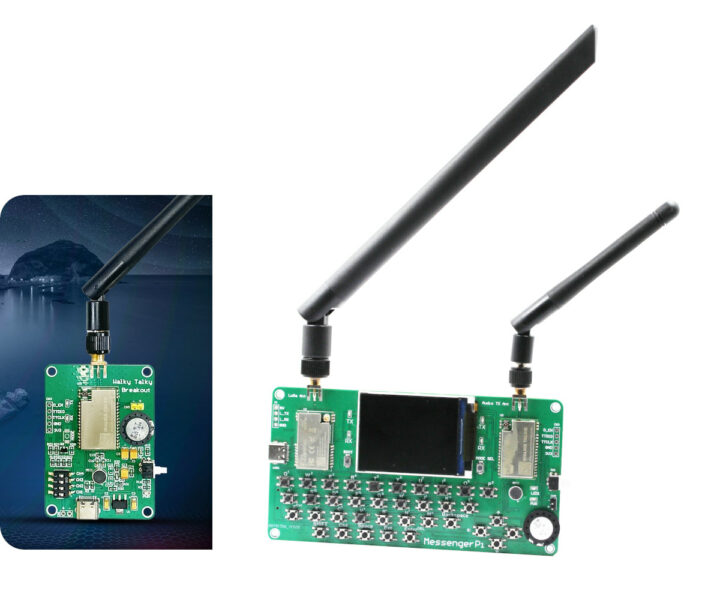SB Components MessengerPi is a DIY messenger and walkie-talkie based on a Raspberry Pi RP2040 that relies on LoRa communication for P2P messaging over distances of up to 5 kilometers and calls up to 300 meters away.
The company actually provides two boards: the MessengerPi itself for both calls and messaging with a keyboard, and the smaller “Walky Talky” board for audio communication only and without a LoRa module.
Messenger Pi specifications:
- MCU – Raspberry Pi RP2040 dual-core Cortex-M0+ microcontroller @ 133 MHz with 264KB SRAM
- Storage – MicroSD card slot
- Wireless
- Ebyte E22-900T22S LoRa module (also used in the company’s LoRa HAT for Raspberry Pi)
- Based on the Semtech SX1262 transceiver
- Operates in the 850 MHz to 930 MHz band
- Up to 5km LoRa text messaging
- SB Components marked Walkie-Talkie module
- 16 FRS channels
- Tx Power – Up to 17 dBm
- Rx sensitivity – Up to -98dBm
- Audio communication up to a 300-meter range
- One-to-one & one-to-many broadcasting support
- Two SMA antennas for LoRa and Audio transmission
- Ebyte E22-900T22S LoRa module (also used in the company’s LoRa HAT for Raspberry Pi)
- Display – 2-inch display
- Audio – Built-in microphone and speaker, 3.5mm jack for optional external speaker attached to board (see video below).
- User input
- QWERTY keypad
- Push to Talk button for walkie-talkie function
- Boot button for programming the RP2040 MCU
- USB – USB Type-C port for power and programming
- Misc – DIP switches for configuration
- Power Supply – 2-pin connector for 3.7V LiPo battery, USB-C port for charging.
 The DIY Walky Talky board is basically the same minus all parts related to LoRa messaging (LoRa module, keyboard, and display). The MessengerPi and DIY Walky Talky boards would mostly be useful for outdoor communications when hiking, farming, boating, etc… outside the range of any cellular networks, but SB Components won’t provide an enclosure, so you’d better hope it won’t rain, or keep the board in your RV, tractor, or boat…
The DIY Walky Talky board is basically the same minus all parts related to LoRa messaging (LoRa module, keyboard, and display). The MessengerPi and DIY Walky Talky boards would mostly be useful for outdoor communications when hiking, farming, boating, etc… outside the range of any cellular networks, but SB Components won’t provide an enclosure, so you’d better hope it won’t rain, or keep the board in your RV, tractor, or boat…
As usual, the company does not provide any details or source code about the firmware during the crowdfunding campaign, so you have to trust them and cannot evaluate the software support before pledging your hard-earned money. They typically release libraries and sample code on their GitHub account but only have funding received. In the meantime, you can still watch a promotion and demo video below.
The Messenger Pi and Walky Takly boards have recently been launched on Kickstarter with a lowly 500 GBP funding target (about $620). Rewards start at $49 US for a pair of DIY “Walky Talky” boards and $138 for two MessengerPi boards. Shipping adds 7 GBP to the UK and about $19 to the rest of the world, and backers should expect their rewards to ship by March 2024 if everything goes according to plan.

Jean-Luc started CNX Software in 2010 as a part-time endeavor, before quitting his job as a software engineering manager, and starting to write daily news, and reviews full time later in 2011.
Support CNX Software! Donate via cryptocurrencies, become a Patron on Patreon, or purchase goods on Amazon or Aliexpress





